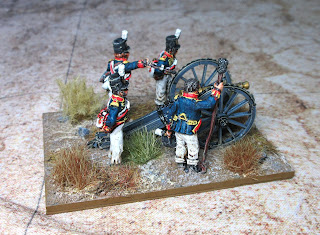After another long pause it's nice to get another Battalion painted up and ready for action. This time its the 1st Battalion of the 48th (Northamptonshire) Regiment of Foot. This Regiment had two Battalions at the Battle of Albuera.
Having visited the battlefield of Albuera last year, I have focused on painting units which were there. The battlefield is pretty well unspoiled and the visitor is left with no doubt as to what a terrible slogging match the battle was on those barren open slopes. This does leave a great impression on one's mind and also captures the imagination in terms of painting inspiration. I have no idea how those troops just stood there in an ever shrinking line while hell was unleashed upon them I think the main reason that I want to represent them is that I was just left in awe of them.
Above and below - The Light Infantry Company at the far left of the line with their green plumes
The figures are from the marvelous Perry Miniatures British Infantry box. This box gives options for the Peninsular or later 'Waterloo' uniform. The poses are for a firing line with a number of positions for loading, reaching for ammunition, cocking and aiming. Some might prefer a more uniform appearance, and I would have done once, but I have no doubt that with the full noise of battle, very few are going to hear shouted firing orders after that first volley in the midst of battle, and the men will keep loading and firing on their own until an NCO slaps a man on the shoulder to cease.



My intention is to use these troops with the General d'Armee 2 rules after having play-tested them recently. The rules are certainly detailed, though I am sure I will play faster with them once I get more used to them. I did enjoy using the rules and it did 'feel' Napoleonic which very few other rules I have used ever have done. The GDA2 Facebook group is also a valuable resource as I was really stuck with understanding the orders phase. Putting the question up on the group brought a very helpful answer and all became clear.
Above and below - The Grenadier Company with their white plumes from the extreme right of the line
I am pleased with my change to a 50mm x 50mm stand for the troops (from 60mm x 50mm). I like the closer order appearance. It's funny how just a reduction of 10mm width can reduce the base size so that it changes the look so much for the better.
The exception to this is the command stand. I tried to use the new size of base but with flags that glorious (made by GMB), there was no way that I would want to reduce them to make everything fit. British command stands will be 60mm x 50mm for me and I am perfectly happy with that.
Above and below - the command stand. I paint the flags with PVA glue and let it fully dry, before bending the wavy folds carefully into them. This helps to prevent the print detaching from the paper at the folds. I then apply a matt varnish spray over the whole to protect them (prior to basing)
I found it less daunting to paint just 12 figures at a time and then finish by painting the 5 man command stand. This was good as it made painting the lace and detail less painful. I type up a painting procedure of steps and paints used for every soldier type that I paint, and keep it in a large lever arch file. This way I don't forget which paints I used, and also I keep keep notes of any other information that helps (i.e. reminders to use certain arms for certain figures etc).
Below - The magnetic sheet basing with printed label. The label gets a coat of PVA glue too to protect it
I have some extra painting time at the moment as I'm currently between jobs. I completed these figures about 9 days ago. In the 9 days since, I have painted up another whole Battalion as a production line instead of in the usual batches of 12 figures. This was complete insanity and I am burned out! I'll post photos of that Battalion in due course, in the meantime I feel like doing something completely different...and with no lace!



















































